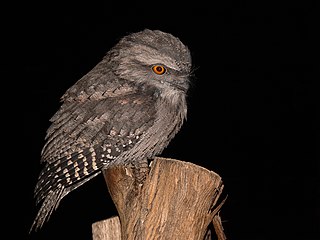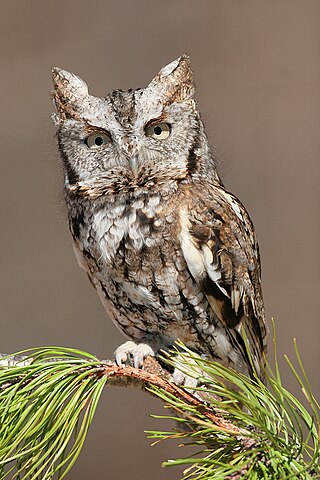
The barn owl is the most widely distributed species of owl in the world and one of the most widespread of all species of birds, living almost everywhere except for polar and desert regions, Asia north of the Himalayas, some Indonesian islands and some Pacific Islands. It is also known as the common barn owl, to distinguish it from the other species in its family, Tytonidae, which forms one of the two main lineages of living owls, the other being the typical owls.

The frogmouths (Podargidae) are a group of nocturnal birds related to owlet-nightjars, swifts, and hummingbirds. Species in the group are distributed in the Indomalayan and Australasian realms.

The long-eared owl, also known as the northern long-eared owl or, more informally, as the lesser horned owl or cat owl, is a medium-sized species of owl with an extensive breeding range. The genus name, Asio, is Latin for "horned owl", and the specific epithet, otus, is derived from Greek and refers to a small eared owl. The species breeds in many areas through Europe and the Palearctic, as well as in North America. This species is a part of the larger grouping of owls known as typical owls, of the family Strigidae, which contains most extant species of owl.

The eastern screech owl or eastern screech-owl, is a small owl that is relatively common in Eastern North America, from Mexico to Canada. This species resides in most types of woodland habitats across its range, and is relatively adaptable to urban and developed areas compared to other owls. Although it often lives in close proximity to humans, the eastern screech owl frequently avoids detection due to its strictly nocturnal habits.

The tawny eagle is a large bird of prey. Like all eagles, it belongs to the family Accipitridae. Its heavily feathered legs mark it as a member of the subfamily Aquilinae, also known as booted eagles. Tawny eagles have an extensive but discontinuous breeding range that constitutes much of the African continent as well as the Indian subcontinent, with rare residency in the southern Middle East. Throughout its range, it favours open dry habitats such as semideserts, deserts steppes, or savanna plains. Despite its preference for arid areas, the species seldom occurs in areas where trees are entirely absent. It is a resident breeder which lays one to three eggs in a stick nest most commonly in the crown of a tree. The tawny eagle is perhaps the most highly opportunistic of all Aquilinae, and often scavenges on carrion or engages in kleptoparasitism towards other carnivorous animals but is also a bold and active predator, often of relatively large and diverse prey. It is estimated that tawny eagles can reach the age of 16 years old. Nonetheless, precipitous declines have been detected throughout the tawny eagle's range. Numerous factors, particularly loss of nesting habitat due to logging and global warming, as well as persecution and other anthropogenic mortality are driving the once numerous tawny eagle perhaps to the brink of extinction.

The Ural owl is a large nocturnal owl. It is a member of the true owl family, Strigidae. The Ural owl is a member of the genus Strix, that is also the origin of the family's name under Linnaean taxonomy. Both its common name and scientific name refer to the Ural Mountains of Russia where the type specimen was collected. However, this species has an extremely broad distribution that extends as far west as much of Scandinavia, montane eastern Europe, and, sporadically, central Europe, thence sweeping across the Palearctic broadly through Russia to as far east as Sakhalin and throughout Japan. The Ural owl may include up to 15 subspecies, but most likely the number may be slightly fewer if accounting for clinal variations.

The Australian owlet-nightjar is a nocturnal bird found in open woodland across Australia and in southern New Guinea. It is colloquially known as the moth owl. It is the most common nocturnal bird in Australia, and despite suffering from predation and competition by introduced species it is not considered threatened.

The powerful owl, a species of owl native to south-eastern and eastern Australia, is the largest owl on the continent. It is found in coastal areas and in the Great Dividing Range, rarely more than 200 km (120 mi) inland. The IUCN Red List of Threatened Species also refers to this species as the powerful boobook.

The great potoo or grand potoo is the largest potoo species and is widely distributed in Central and South America.

The spotted nightjar or spotted eared-nightjar is a species of nightjar in the family Caprimulgidae. It inhabits much of mainland Australia and has also been found in several Indonesian islands. Its natural habitats are open forests and woodlands, scrub, spinifex and tussock grassland, savannah woodland and mangroves.

The Cape eagle-owl is a species of owl in the family Strigidae. It is one of several large species of the eagle-owl genus Bubo.

Pel's fishing owl is a large species of owl in the family Strigidae, found in Africa. It lives near rivers and lakes, and feeds nocturnally on fish and frogs snatched from the surface of lakes and rivers. The species prefers slow-moving rivers with large, overhanging trees to roost in and forage from. It nests in hollows and the forks of large trees. Though as many as two eggs are laid, often only one chick is raised.

The Blyth’s frogmouth is a species of bird in the family Podargidae. They are brownish or rufescent brown with a slightly round bill and tail, and have tufts of bristles in front of the eyes and at the base of the bill. Batrachostomus occur from India and Sri Lanka, across mainland southeast Asia and as far as Borneo, Java, and Sumatra. More specifically, the Blyth’s frogmouths are scattered between southeastern Myanmar and Indonesia. Like other frogmouth species, they are insectivorous.

The Sunda frogmouth is a medium sized, old world species of bird within the order Podargiformes. It is also uncommonly referred to as the long-tailed frogmouth or the horned frogmouth. The term "Sunda" is based on the geographical range of the species to regions around the Sunda islands. The genus name, Batrachostomus, is a Greek translation to ‘frogmouth’, which comes from the wide shape of the bill and slight gape. The species name cornutus is a Latin word translated to "having horns", referring to the tufts of feathers on the head.

Hodgson's frogmouth is a species of bird in the family Podargidae. It is found in Bangladesh, Bhutan, China, India, Laos, Myanmar, Thailand, and Vietnam. Its natural habitat is temperate forests.

The marbled frogmouth is a bird in the family Podargidae. The species was first described by Jean René Constant Quoy and Joseph Paul Gaimard in 1830. It is found in the Aru Islands, New Guinea and Queensland. Its natural habitats are subtropical or tropical moist lowland forest and subtropical or tropical moist montane forest.

The Papuan frogmouth is a species of bird in the family Podargidae, found in the Aru Islands, New Guinea, and in Cape York Peninsula, Queensland, Australia.

The tawny owl, also called the brown owl, is a stocky, medium-sized owl in the family Strigidae. It is commonly found in woodlands across Europe, as well as western Siberia, and has seven recognized subspecies. The tawny owl's underparts are pale with dark streaks, whilst its upper body may be either brown or grey. The tawny owl typically makes its nest in a tree hole where it can protect its eggs and young against potential predators. It is non-migratory and highly territorial: as a result, when young birds grow up and leave the parental nest, if they cannot find a vacant territory to claim as their own, they will often starve.

The American barn owl is usually considered a subspecies group and together with the western barn owl group, the eastern barn owl group, and sometimes the Andaman masked owl, make up the barn owl, cosmopolitan in range. The barn owl is recognized by most taxonomic authorities. A few separate them into distinct species, as is done here. The American barn owl is native to North and South America, and has been introduced to Hawaii.






























